CBIS3203: Intelligent System Development Report - Data Soft Solutions
VerifiedAdded on 2023/06/11
|12
|3532
|426
Report
AI Summary
This report delves into the intelligent system development for Data Soft Solutions, an IT solution provider. It highlights the importance of AI in areas like data management, decision-making, HR, error detection, and automation. The report discusses knowledge sources and acquisition, emphasizing internal and external sources. It also covers knowledge design, graphical and statistical methods, and the significance of user interface prototypes for testing usability and functionality. The report aims to provide insights into how Data Soft Solutions can leverage intelligent systems to improve efficiency and decision-making.
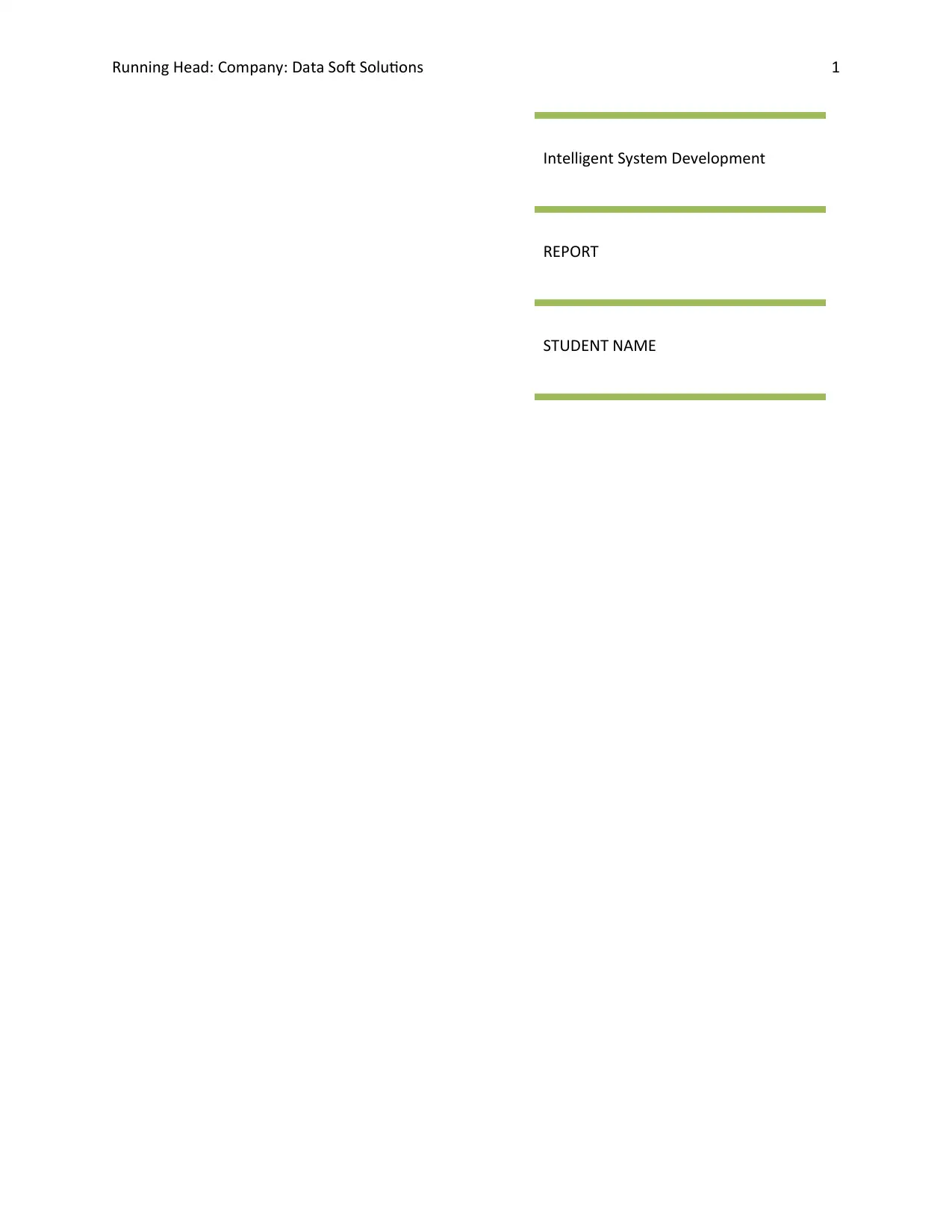
Running Head: Company: Data Soft Solutions 1
Intelligent System Development
REPORT
STUDENT NAME
Intelligent System Development
REPORT
STUDENT NAME
Paraphrase This Document
Need a fresh take? Get an instant paraphrase of this document with our AI Paraphraser
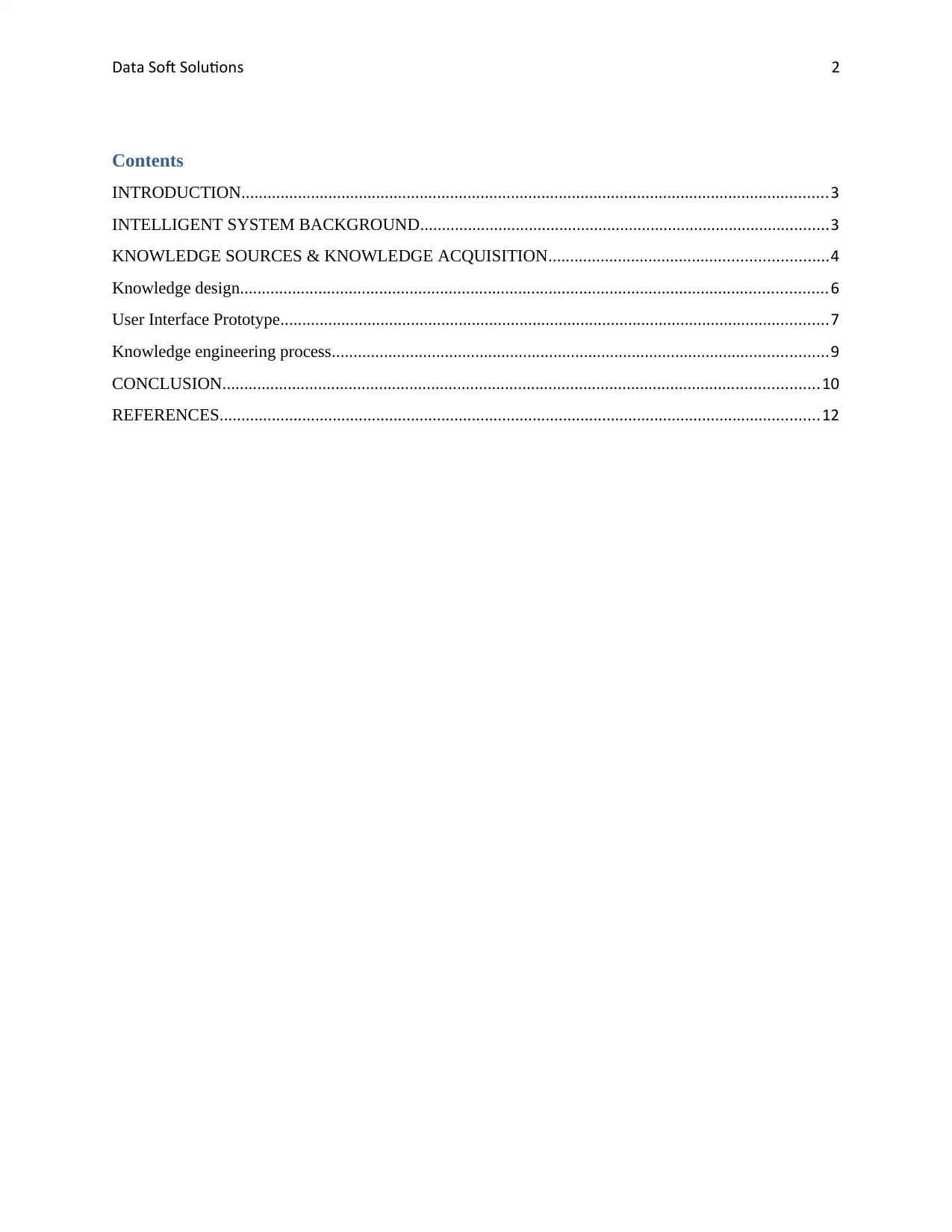
Data Soft Solutions 2
Contents
INTRODUCTION.......................................................................................................................................3
INTELLIGENT SYSTEM BACKGROUND..............................................................................................3
KNOWLEDGE SOURCES & KNOWLEDGE ACQUISITION................................................................4
Knowledge design.......................................................................................................................................6
User Interface Prototype..............................................................................................................................7
Knowledge engineering process..................................................................................................................9
CONCLUSION.........................................................................................................................................10
REFERENCES..........................................................................................................................................12
Contents
INTRODUCTION.......................................................................................................................................3
INTELLIGENT SYSTEM BACKGROUND..............................................................................................3
KNOWLEDGE SOURCES & KNOWLEDGE ACQUISITION................................................................4
Knowledge design.......................................................................................................................................6
User Interface Prototype..............................................................................................................................7
Knowledge engineering process..................................................................................................................9
CONCLUSION.........................................................................................................................................10
REFERENCES..........................................................................................................................................12
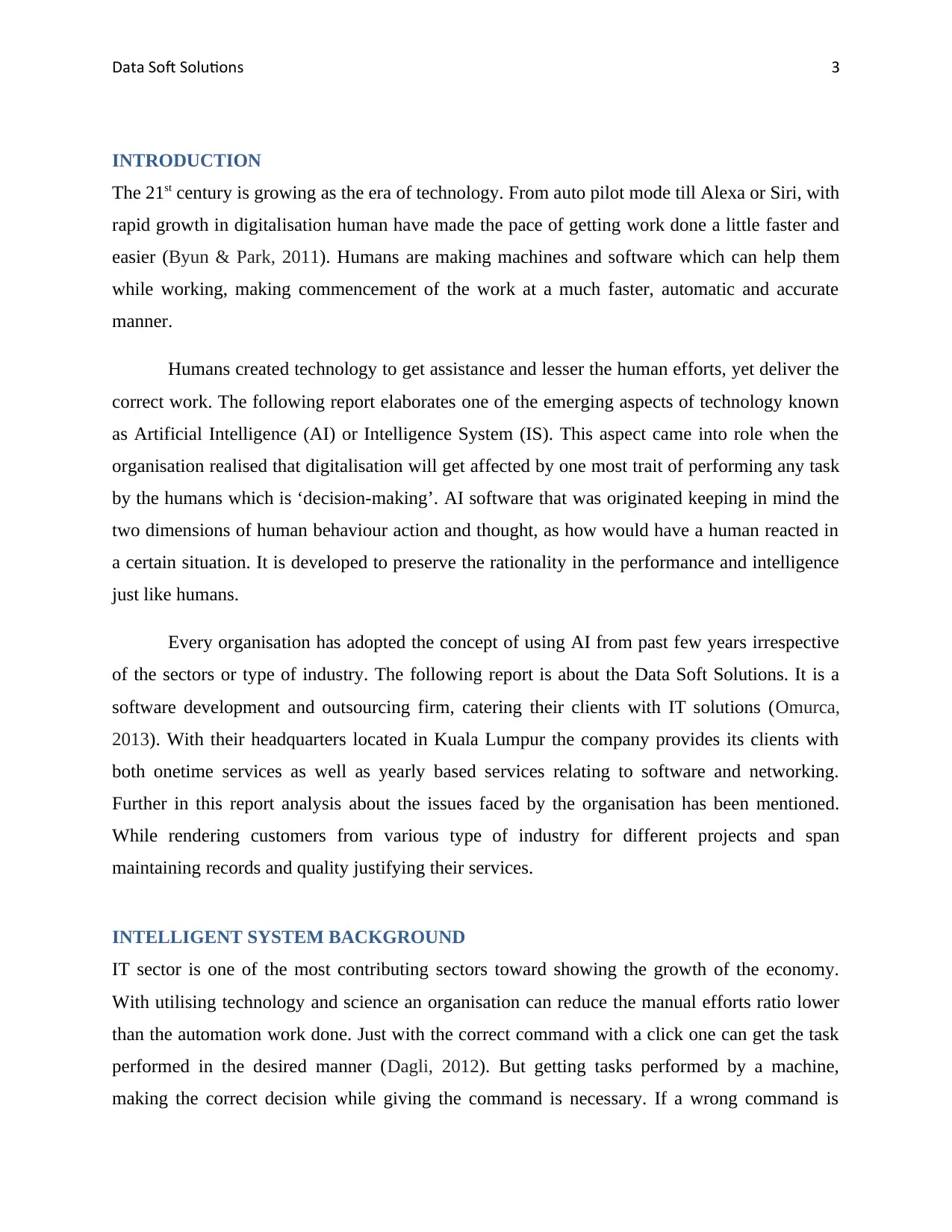
Data Soft Solutions 3
INTRODUCTION
The 21st century is growing as the era of technology. From auto pilot mode till Alexa or Siri, with
rapid growth in digitalisation human have made the pace of getting work done a little faster and
easier (Byun & Park, 2011). Humans are making machines and software which can help them
while working, making commencement of the work at a much faster, automatic and accurate
manner.
Humans created technology to get assistance and lesser the human efforts, yet deliver the
correct work. The following report elaborates one of the emerging aspects of technology known
as Artificial Intelligence (AI) or Intelligence System (IS). This aspect came into role when the
organisation realised that digitalisation will get affected by one most trait of performing any task
by the humans which is ‘decision-making’. AI software that was originated keeping in mind the
two dimensions of human behaviour action and thought, as how would have a human reacted in
a certain situation. It is developed to preserve the rationality in the performance and intelligence
just like humans.
Every organisation has adopted the concept of using AI from past few years irrespective
of the sectors or type of industry. The following report is about the Data Soft Solutions. It is a
software development and outsourcing firm, catering their clients with IT solutions (Omurca,
2013). With their headquarters located in Kuala Lumpur the company provides its clients with
both onetime services as well as yearly based services relating to software and networking.
Further in this report analysis about the issues faced by the organisation has been mentioned.
While rendering customers from various type of industry for different projects and span
maintaining records and quality justifying their services.
INTELLIGENT SYSTEM BACKGROUND
IT sector is one of the most contributing sectors toward showing the growth of the economy.
With utilising technology and science an organisation can reduce the manual efforts ratio lower
than the automation work done. Just with the correct command with a click one can get the task
performed in the desired manner (Dagli, 2012). But getting tasks performed by a machine,
making the correct decision while giving the command is necessary. If a wrong command is
INTRODUCTION
The 21st century is growing as the era of technology. From auto pilot mode till Alexa or Siri, with
rapid growth in digitalisation human have made the pace of getting work done a little faster and
easier (Byun & Park, 2011). Humans are making machines and software which can help them
while working, making commencement of the work at a much faster, automatic and accurate
manner.
Humans created technology to get assistance and lesser the human efforts, yet deliver the
correct work. The following report elaborates one of the emerging aspects of technology known
as Artificial Intelligence (AI) or Intelligence System (IS). This aspect came into role when the
organisation realised that digitalisation will get affected by one most trait of performing any task
by the humans which is ‘decision-making’. AI software that was originated keeping in mind the
two dimensions of human behaviour action and thought, as how would have a human reacted in
a certain situation. It is developed to preserve the rationality in the performance and intelligence
just like humans.
Every organisation has adopted the concept of using AI from past few years irrespective
of the sectors or type of industry. The following report is about the Data Soft Solutions. It is a
software development and outsourcing firm, catering their clients with IT solutions (Omurca,
2013). With their headquarters located in Kuala Lumpur the company provides its clients with
both onetime services as well as yearly based services relating to software and networking.
Further in this report analysis about the issues faced by the organisation has been mentioned.
While rendering customers from various type of industry for different projects and span
maintaining records and quality justifying their services.
INTELLIGENT SYSTEM BACKGROUND
IT sector is one of the most contributing sectors toward showing the growth of the economy.
With utilising technology and science an organisation can reduce the manual efforts ratio lower
than the automation work done. Just with the correct command with a click one can get the task
performed in the desired manner (Dagli, 2012). But getting tasks performed by a machine,
making the correct decision while giving the command is necessary. If a wrong command is
⊘ This is a preview!⊘
Do you want full access?
Subscribe today to unlock all pages.

Trusted by 1+ million students worldwide
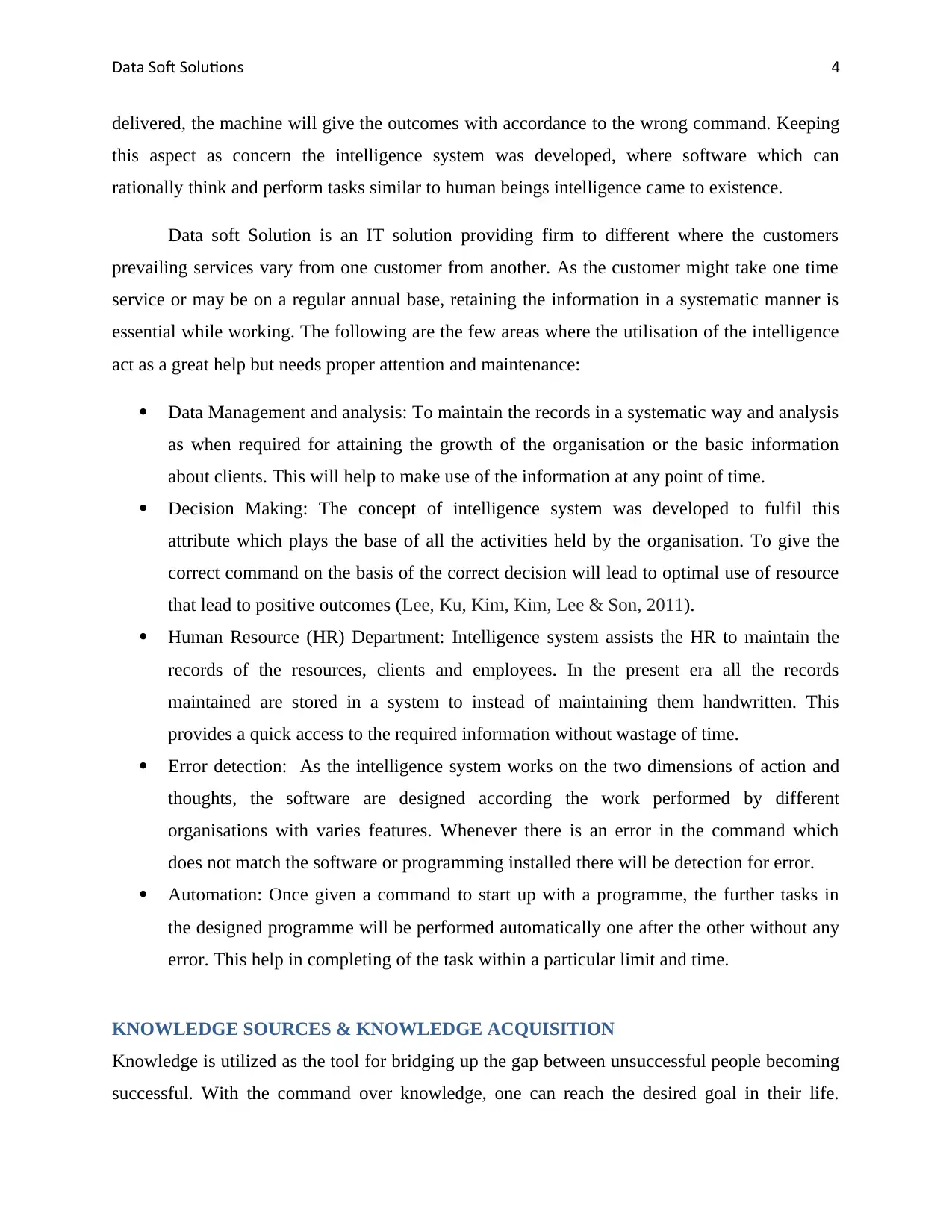
Data Soft Solutions 4
delivered, the machine will give the outcomes with accordance to the wrong command. Keeping
this aspect as concern the intelligence system was developed, where software which can
rationally think and perform tasks similar to human beings intelligence came to existence.
Data soft Solution is an IT solution providing firm to different where the customers
prevailing services vary from one customer from another. As the customer might take one time
service or may be on a regular annual base, retaining the information in a systematic manner is
essential while working. The following are the few areas where the utilisation of the intelligence
act as a great help but needs proper attention and maintenance:
Data Management and analysis: To maintain the records in a systematic way and analysis
as when required for attaining the growth of the organisation or the basic information
about clients. This will help to make use of the information at any point of time.
Decision Making: The concept of intelligence system was developed to fulfil this
attribute which plays the base of all the activities held by the organisation. To give the
correct command on the basis of the correct decision will lead to optimal use of resource
that lead to positive outcomes (Lee, Ku, Kim, Kim, Lee & Son, 2011).
Human Resource (HR) Department: Intelligence system assists the HR to maintain the
records of the resources, clients and employees. In the present era all the records
maintained are stored in a system to instead of maintaining them handwritten. This
provides a quick access to the required information without wastage of time.
Error detection: As the intelligence system works on the two dimensions of action and
thoughts, the software are designed according the work performed by different
organisations with varies features. Whenever there is an error in the command which
does not match the software or programming installed there will be detection for error.
Automation: Once given a command to start up with a programme, the further tasks in
the designed programme will be performed automatically one after the other without any
error. This help in completing of the task within a particular limit and time.
KNOWLEDGE SOURCES & KNOWLEDGE ACQUISITION
Knowledge is utilized as the tool for bridging up the gap between unsuccessful people becoming
successful. With the command over knowledge, one can reach the desired goal in their life.
delivered, the machine will give the outcomes with accordance to the wrong command. Keeping
this aspect as concern the intelligence system was developed, where software which can
rationally think and perform tasks similar to human beings intelligence came to existence.
Data soft Solution is an IT solution providing firm to different where the customers
prevailing services vary from one customer from another. As the customer might take one time
service or may be on a regular annual base, retaining the information in a systematic manner is
essential while working. The following are the few areas where the utilisation of the intelligence
act as a great help but needs proper attention and maintenance:
Data Management and analysis: To maintain the records in a systematic way and analysis
as when required for attaining the growth of the organisation or the basic information
about clients. This will help to make use of the information at any point of time.
Decision Making: The concept of intelligence system was developed to fulfil this
attribute which plays the base of all the activities held by the organisation. To give the
correct command on the basis of the correct decision will lead to optimal use of resource
that lead to positive outcomes (Lee, Ku, Kim, Kim, Lee & Son, 2011).
Human Resource (HR) Department: Intelligence system assists the HR to maintain the
records of the resources, clients and employees. In the present era all the records
maintained are stored in a system to instead of maintaining them handwritten. This
provides a quick access to the required information without wastage of time.
Error detection: As the intelligence system works on the two dimensions of action and
thoughts, the software are designed according the work performed by different
organisations with varies features. Whenever there is an error in the command which
does not match the software or programming installed there will be detection for error.
Automation: Once given a command to start up with a programme, the further tasks in
the designed programme will be performed automatically one after the other without any
error. This help in completing of the task within a particular limit and time.
KNOWLEDGE SOURCES & KNOWLEDGE ACQUISITION
Knowledge is utilized as the tool for bridging up the gap between unsuccessful people becoming
successful. With the command over knowledge, one can reach the desired goal in their life.
Paraphrase This Document
Need a fresh take? Get an instant paraphrase of this document with our AI Paraphraser

Data Soft Solutions 5
Knowledge is the key requirement towards the success of either an individual or any
organisation. Intelligence system is developed to resolve the problems faced by the organisation
which if done manually will consume a lot of time. Knowledge sources are the base to formulate
the intelligence system whereas when the problem solution is turned into actions, which means
the developer create software with accordance to resolve the problem (Zhu & Azar, 2015).
For any small scale organisation there are various sources of knowledge but the most essential
sources are the database that gets information from various organisational operations. It is
essential that an organisation maintains its platforms from where they can gain various data.
There must be installation of systems within the organisation that would help in gaining
knowledge from both external and internal sources. These sources are highly helpful in the
making of the decisions.
The internal sources such as innovation process, R & D efforts, training program and continuous
improvement process are some of the major sources of knowledge in any small business
organisations. In the later stage of the organisational development, activities performed within
the firm also acts as a Knowledge source. It is crucial that a company understands bases of
knowledge as it justifies the sources of knowledge (Ducange, Fazzolari, Lazzerini & Marcelloni,
2011). In this regards more crucial role is played by the players involved in the knowledge
management. These knowledge sources play a very vital role in the development of innovation
and development process. Other than this skill of employees also acts as an internal source of
knowledge.
Apart from this there are external sources that contribute to the knowledge. Supply chain
management and stakeholders plays a very vital role. Along with this global and industry
business environment plays a very crucial role in gaining of the knowledge. The cooperation
with suppliers and customers also adds to the knowledge.
Knowledge acquisition is another crucial aspect in the knowledge management. It is a process of
extracting, structuring and organising knowledge from one source mainly humans. The
knowledge that is gathered through various sources needs to be structured and organised in such
a manner that information from it can be easily accessed (BORRAJO, Baruque, Corchado, Bajo
& Corchado, 2011). The better the organising of the information, the easier it is to gain
Knowledge is the key requirement towards the success of either an individual or any
organisation. Intelligence system is developed to resolve the problems faced by the organisation
which if done manually will consume a lot of time. Knowledge sources are the base to formulate
the intelligence system whereas when the problem solution is turned into actions, which means
the developer create software with accordance to resolve the problem (Zhu & Azar, 2015).
For any small scale organisation there are various sources of knowledge but the most essential
sources are the database that gets information from various organisational operations. It is
essential that an organisation maintains its platforms from where they can gain various data.
There must be installation of systems within the organisation that would help in gaining
knowledge from both external and internal sources. These sources are highly helpful in the
making of the decisions.
The internal sources such as innovation process, R & D efforts, training program and continuous
improvement process are some of the major sources of knowledge in any small business
organisations. In the later stage of the organisational development, activities performed within
the firm also acts as a Knowledge source. It is crucial that a company understands bases of
knowledge as it justifies the sources of knowledge (Ducange, Fazzolari, Lazzerini & Marcelloni,
2011). In this regards more crucial role is played by the players involved in the knowledge
management. These knowledge sources play a very vital role in the development of innovation
and development process. Other than this skill of employees also acts as an internal source of
knowledge.
Apart from this there are external sources that contribute to the knowledge. Supply chain
management and stakeholders plays a very vital role. Along with this global and industry
business environment plays a very crucial role in gaining of the knowledge. The cooperation
with suppliers and customers also adds to the knowledge.
Knowledge acquisition is another crucial aspect in the knowledge management. It is a process of
extracting, structuring and organising knowledge from one source mainly humans. The
knowledge that is gathered through various sources needs to be structured and organised in such
a manner that information from it can be easily accessed (BORRAJO, Baruque, Corchado, Bajo
& Corchado, 2011). The better the organising of the information, the easier it is to gain
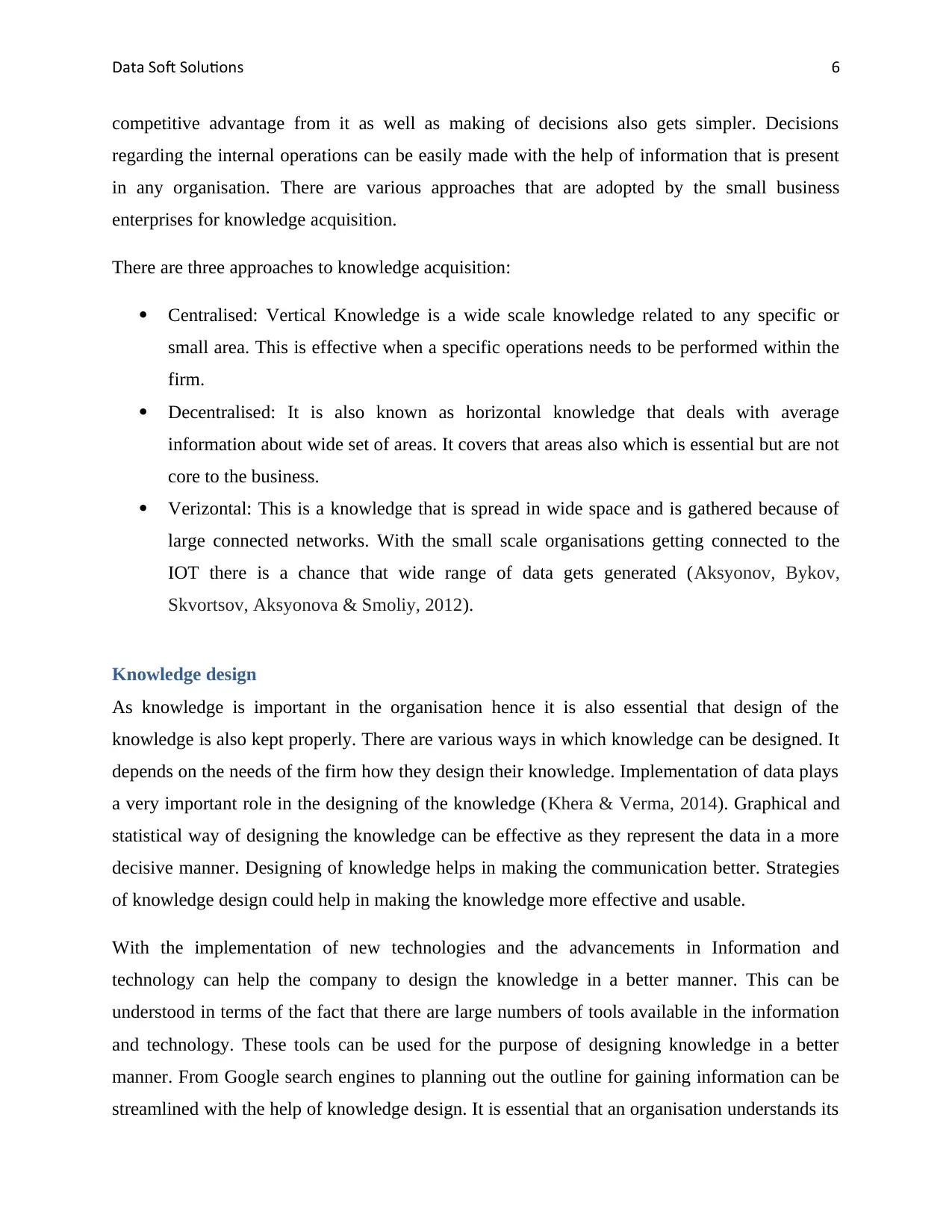
Data Soft Solutions 6
competitive advantage from it as well as making of decisions also gets simpler. Decisions
regarding the internal operations can be easily made with the help of information that is present
in any organisation. There are various approaches that are adopted by the small business
enterprises for knowledge acquisition.
There are three approaches to knowledge acquisition:
Centralised: Vertical Knowledge is a wide scale knowledge related to any specific or
small area. This is effective when a specific operations needs to be performed within the
firm.
Decentralised: It is also known as horizontal knowledge that deals with average
information about wide set of areas. It covers that areas also which is essential but are not
core to the business.
Verizontal: This is a knowledge that is spread in wide space and is gathered because of
large connected networks. With the small scale organisations getting connected to the
IOT there is a chance that wide range of data gets generated (Aksyonov, Bykov,
Skvortsov, Aksyonova & Smoliy, 2012).
Knowledge design
As knowledge is important in the organisation hence it is also essential that design of the
knowledge is also kept properly. There are various ways in which knowledge can be designed. It
depends on the needs of the firm how they design their knowledge. Implementation of data plays
a very important role in the designing of the knowledge (Khera & Verma, 2014). Graphical and
statistical way of designing the knowledge can be effective as they represent the data in a more
decisive manner. Designing of knowledge helps in making the communication better. Strategies
of knowledge design could help in making the knowledge more effective and usable.
With the implementation of new technologies and the advancements in Information and
technology can help the company to design the knowledge in a better manner. This can be
understood in terms of the fact that there are large numbers of tools available in the information
and technology. These tools can be used for the purpose of designing knowledge in a better
manner. From Google search engines to planning out the outline for gaining information can be
streamlined with the help of knowledge design. It is essential that an organisation understands its
competitive advantage from it as well as making of decisions also gets simpler. Decisions
regarding the internal operations can be easily made with the help of information that is present
in any organisation. There are various approaches that are adopted by the small business
enterprises for knowledge acquisition.
There are three approaches to knowledge acquisition:
Centralised: Vertical Knowledge is a wide scale knowledge related to any specific or
small area. This is effective when a specific operations needs to be performed within the
firm.
Decentralised: It is also known as horizontal knowledge that deals with average
information about wide set of areas. It covers that areas also which is essential but are not
core to the business.
Verizontal: This is a knowledge that is spread in wide space and is gathered because of
large connected networks. With the small scale organisations getting connected to the
IOT there is a chance that wide range of data gets generated (Aksyonov, Bykov,
Skvortsov, Aksyonova & Smoliy, 2012).
Knowledge design
As knowledge is important in the organisation hence it is also essential that design of the
knowledge is also kept properly. There are various ways in which knowledge can be designed. It
depends on the needs of the firm how they design their knowledge. Implementation of data plays
a very important role in the designing of the knowledge (Khera & Verma, 2014). Graphical and
statistical way of designing the knowledge can be effective as they represent the data in a more
decisive manner. Designing of knowledge helps in making the communication better. Strategies
of knowledge design could help in making the knowledge more effective and usable.
With the implementation of new technologies and the advancements in Information and
technology can help the company to design the knowledge in a better manner. This can be
understood in terms of the fact that there are large numbers of tools available in the information
and technology. These tools can be used for the purpose of designing knowledge in a better
manner. From Google search engines to planning out the outline for gaining information can be
streamlined with the help of knowledge design. It is essential that an organisation understands its
⊘ This is a preview!⊘
Do you want full access?
Subscribe today to unlock all pages.

Trusted by 1+ million students worldwide

Data Soft Solutions 7
nature of work and then think of designing the knowledge. The statistical approach is always
good for the small scale organisation as it will help them in making decisions with least efforts
(Relich & Muszyński, 2014). It is also easier to explain and takeout the outcomes of any
decisions based on the statistical approach. The most basic part of the knowledge design is the
achievability of the purpose that company wants to achieve from its knowledge base.
User Interface Prototype
User Interface prototypes are designed as per the requirement of the firm. The whole system is
designed, analysed and implemented beforehand only. The major aim before designing of user-
interface prototype is to be able to test and expose both the usability and functionality of the
system. Prototype is made before real system design and development begins. This will help any
small scale organisation to ensure that they are building the system in a correct manner. In this
manner right system can be built in less time and with effective resources. Since the prototypes
can be redesigned as many times as possible hence it is easier for the organisations to come up
with the exact systems when required. It is crucial that organisation come up with the mock-up
version of the UI so that when actual version of it comes there would be no such problems. It
gives the exact idea about the usability of the system that is going to be designed (Czubenko,
Kowalczuk & Ordys, 2015).
Small organisations do not have many resources available with them hence it is crucial that
prototypes designed must be significantly cheaper without compromising with ability to support
essential functionality. A prototype may not have codes to connect layers, no graphics, no
standard implementation and even it is not essential to have complete data. Changes must be
done as per the change request mechanism.
nature of work and then think of designing the knowledge. The statistical approach is always
good for the small scale organisation as it will help them in making decisions with least efforts
(Relich & Muszyński, 2014). It is also easier to explain and takeout the outcomes of any
decisions based on the statistical approach. The most basic part of the knowledge design is the
achievability of the purpose that company wants to achieve from its knowledge base.
User Interface Prototype
User Interface prototypes are designed as per the requirement of the firm. The whole system is
designed, analysed and implemented beforehand only. The major aim before designing of user-
interface prototype is to be able to test and expose both the usability and functionality of the
system. Prototype is made before real system design and development begins. This will help any
small scale organisation to ensure that they are building the system in a correct manner. In this
manner right system can be built in less time and with effective resources. Since the prototypes
can be redesigned as many times as possible hence it is easier for the organisations to come up
with the exact systems when required. It is crucial that organisation come up with the mock-up
version of the UI so that when actual version of it comes there would be no such problems. It
gives the exact idea about the usability of the system that is going to be designed (Czubenko,
Kowalczuk & Ordys, 2015).
Small organisations do not have many resources available with them hence it is crucial that
prototypes designed must be significantly cheaper without compromising with ability to support
essential functionality. A prototype may not have codes to connect layers, no graphics, no
standard implementation and even it is not essential to have complete data. Changes must be
done as per the change request mechanism.
Paraphrase This Document
Need a fresh take? Get an instant paraphrase of this document with our AI Paraphraser
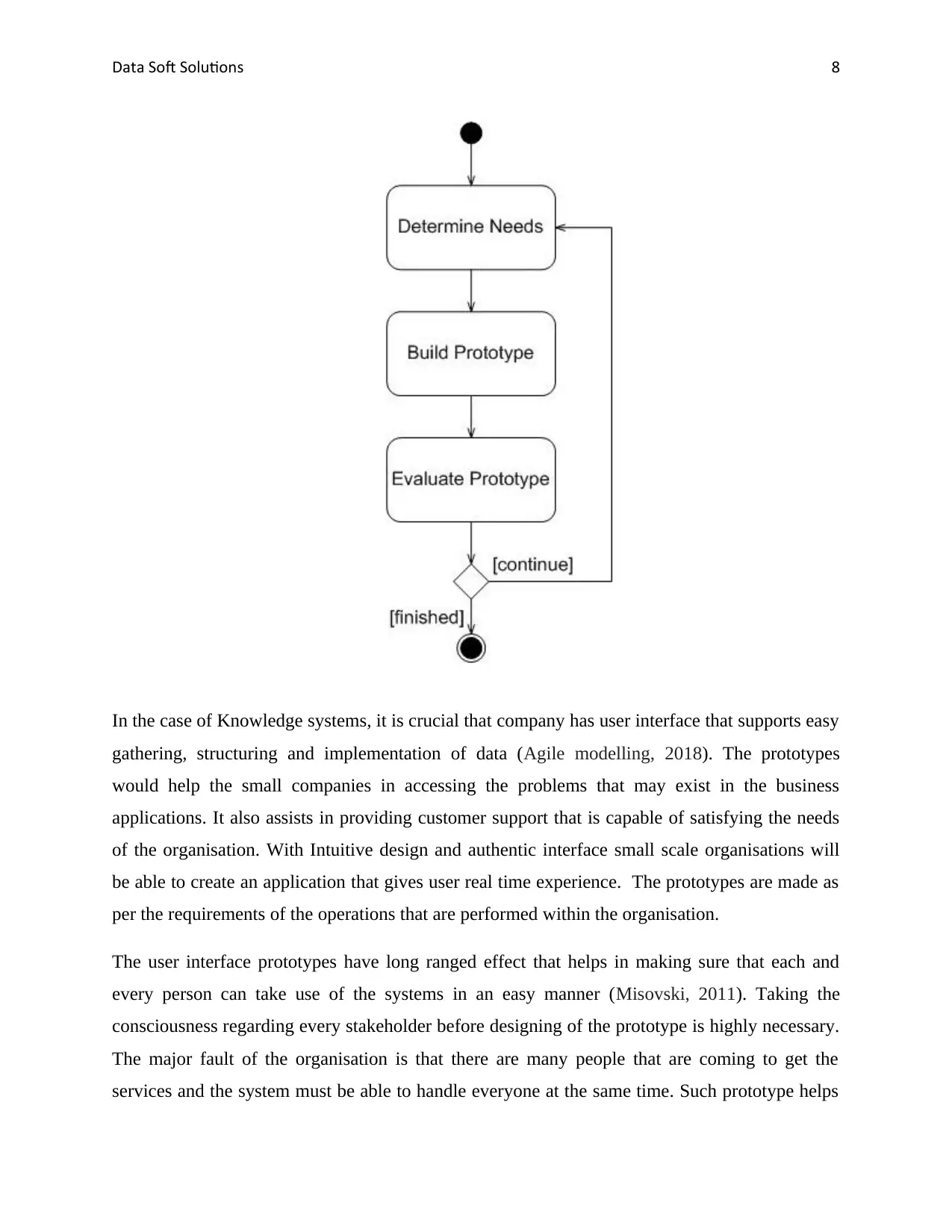
Data Soft Solutions 8
In the case of Knowledge systems, it is crucial that company has user interface that supports easy
gathering, structuring and implementation of data (Agile modelling, 2018). The prototypes
would help the small companies in accessing the problems that may exist in the business
applications. It also assists in providing customer support that is capable of satisfying the needs
of the organisation. With Intuitive design and authentic interface small scale organisations will
be able to create an application that gives user real time experience. The prototypes are made as
per the requirements of the operations that are performed within the organisation.
The user interface prototypes have long ranged effect that helps in making sure that each and
every person can take use of the systems in an easy manner (Misovski, 2011). Taking the
consciousness regarding every stakeholder before designing of the prototype is highly necessary.
The major fault of the organisation is that there are many people that are coming to get the
services and the system must be able to handle everyone at the same time. Such prototype helps
In the case of Knowledge systems, it is crucial that company has user interface that supports easy
gathering, structuring and implementation of data (Agile modelling, 2018). The prototypes
would help the small companies in accessing the problems that may exist in the business
applications. It also assists in providing customer support that is capable of satisfying the needs
of the organisation. With Intuitive design and authentic interface small scale organisations will
be able to create an application that gives user real time experience. The prototypes are made as
per the requirements of the operations that are performed within the organisation.
The user interface prototypes have long ranged effect that helps in making sure that each and
every person can take use of the systems in an easy manner (Misovski, 2011). Taking the
consciousness regarding every stakeholder before designing of the prototype is highly necessary.
The major fault of the organisation is that there are many people that are coming to get the
services and the system must be able to handle everyone at the same time. Such prototype helps
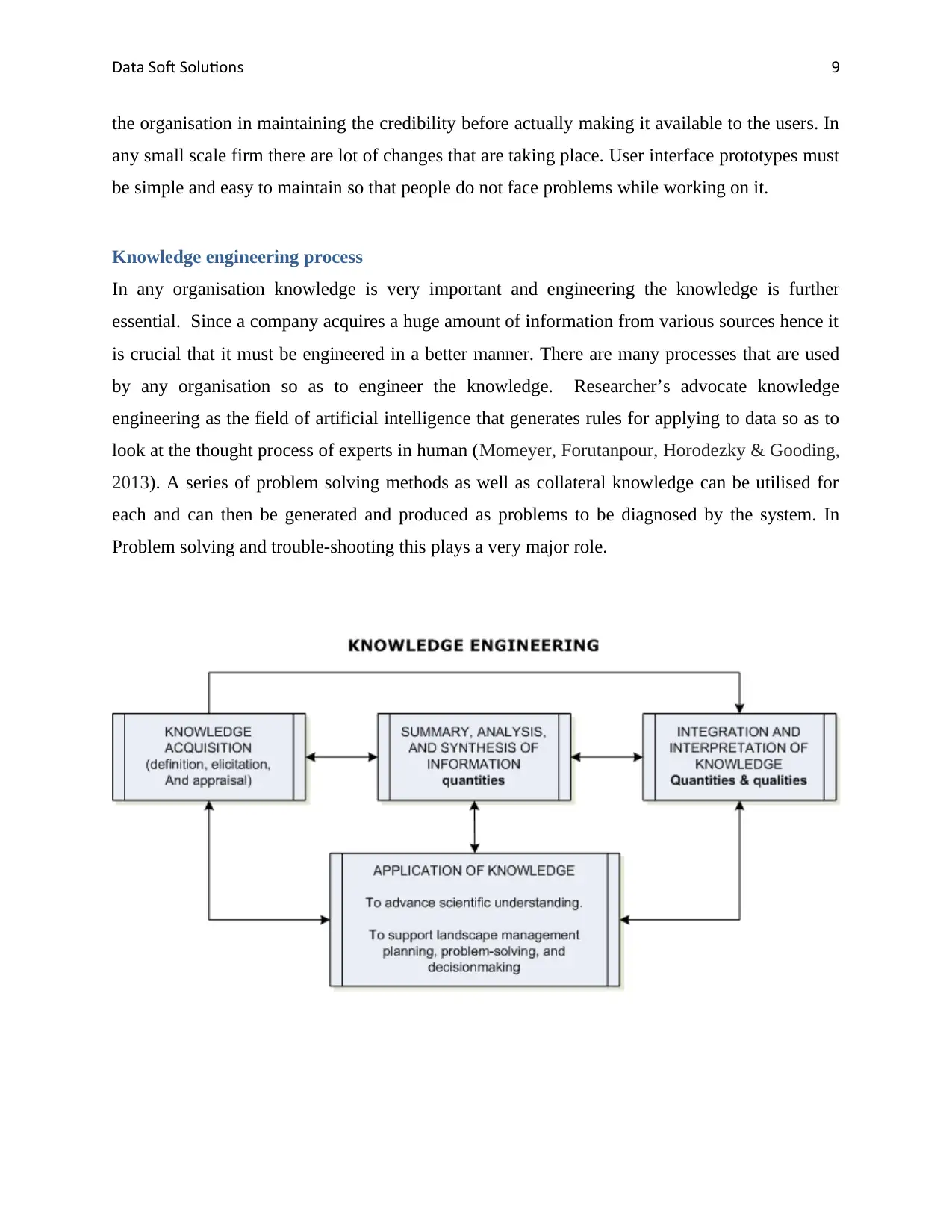
Data Soft Solutions 9
the organisation in maintaining the credibility before actually making it available to the users. In
any small scale firm there are lot of changes that are taking place. User interface prototypes must
be simple and easy to maintain so that people do not face problems while working on it.
Knowledge engineering process
In any organisation knowledge is very important and engineering the knowledge is further
essential. Since a company acquires a huge amount of information from various sources hence it
is crucial that it must be engineered in a better manner. There are many processes that are used
by any organisation so as to engineer the knowledge. Researcher’s advocate knowledge
engineering as the field of artificial intelligence that generates rules for applying to data so as to
look at the thought process of experts in human (Momeyer, Forutanpour, Horodezky & Gooding,
2013). A series of problem solving methods as well as collateral knowledge can be utilised for
each and can then be generated and produced as problems to be diagnosed by the system. In
Problem solving and trouble-shooting this plays a very major role.
the organisation in maintaining the credibility before actually making it available to the users. In
any small scale firm there are lot of changes that are taking place. User interface prototypes must
be simple and easy to maintain so that people do not face problems while working on it.
Knowledge engineering process
In any organisation knowledge is very important and engineering the knowledge is further
essential. Since a company acquires a huge amount of information from various sources hence it
is crucial that it must be engineered in a better manner. There are many processes that are used
by any organisation so as to engineer the knowledge. Researcher’s advocate knowledge
engineering as the field of artificial intelligence that generates rules for applying to data so as to
look at the thought process of experts in human (Momeyer, Forutanpour, Horodezky & Gooding,
2013). A series of problem solving methods as well as collateral knowledge can be utilised for
each and can then be generated and produced as problems to be diagnosed by the system. In
Problem solving and trouble-shooting this plays a very major role.
⊘ This is a preview!⊘
Do you want full access?
Subscribe today to unlock all pages.

Trusted by 1+ million students worldwide
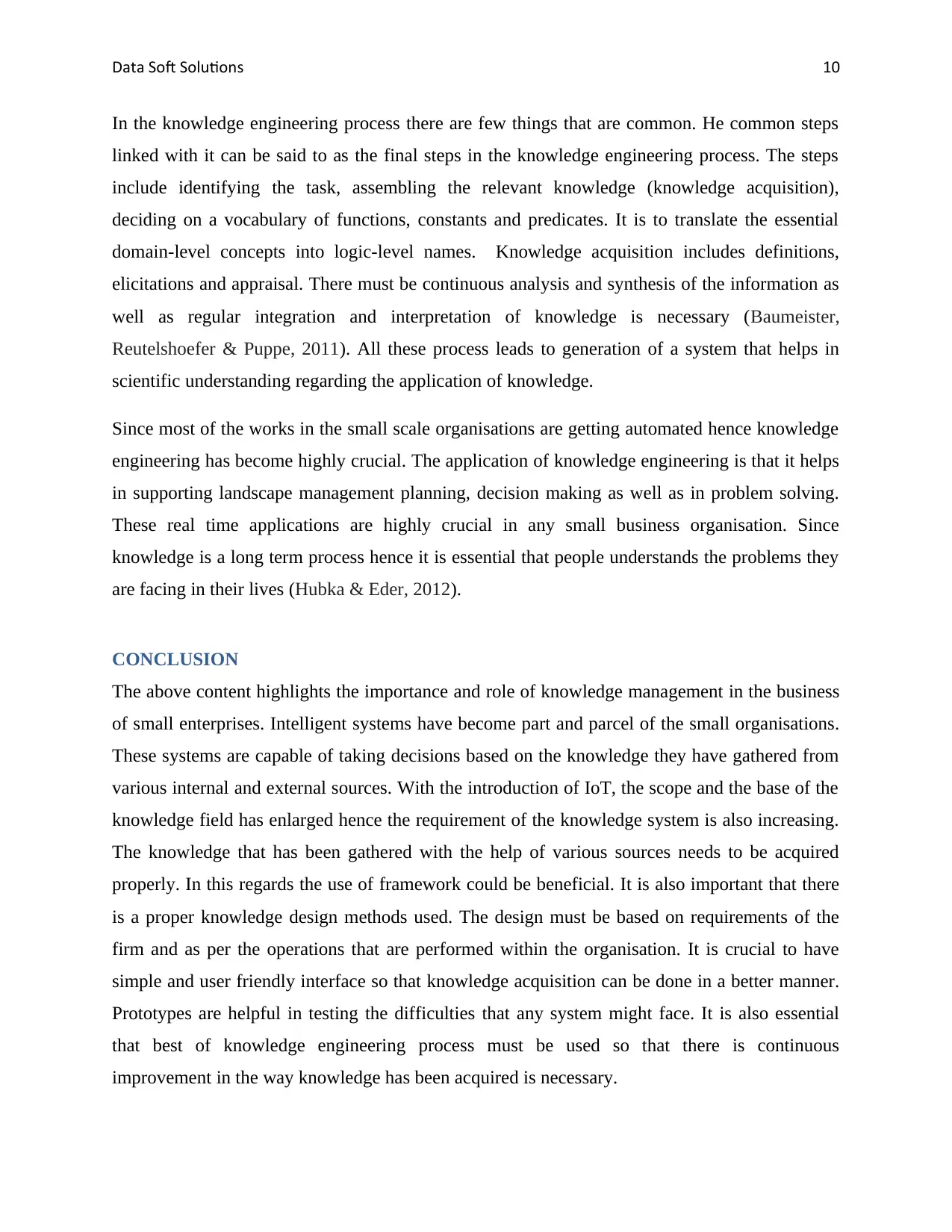
Data Soft Solutions 10
In the knowledge engineering process there are few things that are common. He common steps
linked with it can be said to as the final steps in the knowledge engineering process. The steps
include identifying the task, assembling the relevant knowledge (knowledge acquisition),
deciding on a vocabulary of functions, constants and predicates. It is to translate the essential
domain-level concepts into logic-level names. Knowledge acquisition includes definitions,
elicitations and appraisal. There must be continuous analysis and synthesis of the information as
well as regular integration and interpretation of knowledge is necessary (Baumeister,
Reutelshoefer & Puppe, 2011). All these process leads to generation of a system that helps in
scientific understanding regarding the application of knowledge.
Since most of the works in the small scale organisations are getting automated hence knowledge
engineering has become highly crucial. The application of knowledge engineering is that it helps
in supporting landscape management planning, decision making as well as in problem solving.
These real time applications are highly crucial in any small business organisation. Since
knowledge is a long term process hence it is essential that people understands the problems they
are facing in their lives (Hubka & Eder, 2012).
CONCLUSION
The above content highlights the importance and role of knowledge management in the business
of small enterprises. Intelligent systems have become part and parcel of the small organisations.
These systems are capable of taking decisions based on the knowledge they have gathered from
various internal and external sources. With the introduction of IoT, the scope and the base of the
knowledge field has enlarged hence the requirement of the knowledge system is also increasing.
The knowledge that has been gathered with the help of various sources needs to be acquired
properly. In this regards the use of framework could be beneficial. It is also important that there
is a proper knowledge design methods used. The design must be based on requirements of the
firm and as per the operations that are performed within the organisation. It is crucial to have
simple and user friendly interface so that knowledge acquisition can be done in a better manner.
Prototypes are helpful in testing the difficulties that any system might face. It is also essential
that best of knowledge engineering process must be used so that there is continuous
improvement in the way knowledge has been acquired is necessary.
In the knowledge engineering process there are few things that are common. He common steps
linked with it can be said to as the final steps in the knowledge engineering process. The steps
include identifying the task, assembling the relevant knowledge (knowledge acquisition),
deciding on a vocabulary of functions, constants and predicates. It is to translate the essential
domain-level concepts into logic-level names. Knowledge acquisition includes definitions,
elicitations and appraisal. There must be continuous analysis and synthesis of the information as
well as regular integration and interpretation of knowledge is necessary (Baumeister,
Reutelshoefer & Puppe, 2011). All these process leads to generation of a system that helps in
scientific understanding regarding the application of knowledge.
Since most of the works in the small scale organisations are getting automated hence knowledge
engineering has become highly crucial. The application of knowledge engineering is that it helps
in supporting landscape management planning, decision making as well as in problem solving.
These real time applications are highly crucial in any small business organisation. Since
knowledge is a long term process hence it is essential that people understands the problems they
are facing in their lives (Hubka & Eder, 2012).
CONCLUSION
The above content highlights the importance and role of knowledge management in the business
of small enterprises. Intelligent systems have become part and parcel of the small organisations.
These systems are capable of taking decisions based on the knowledge they have gathered from
various internal and external sources. With the introduction of IoT, the scope and the base of the
knowledge field has enlarged hence the requirement of the knowledge system is also increasing.
The knowledge that has been gathered with the help of various sources needs to be acquired
properly. In this regards the use of framework could be beneficial. It is also important that there
is a proper knowledge design methods used. The design must be based on requirements of the
firm and as per the operations that are performed within the organisation. It is crucial to have
simple and user friendly interface so that knowledge acquisition can be done in a better manner.
Prototypes are helpful in testing the difficulties that any system might face. It is also essential
that best of knowledge engineering process must be used so that there is continuous
improvement in the way knowledge has been acquired is necessary.
Paraphrase This Document
Need a fresh take? Get an instant paraphrase of this document with our AI Paraphraser

Data Soft Solutions 11
REFERENCES
Agile modelling, (2018) User Interface (UI) Prototypes: An Agile Introduction. Retrieved from:
http://agilemodeling.com/artifacts/uiPrototype.htm
Aksyonov, K., Bykov, E., Skvortsov, A., Aksyonova, O., & Smoliy, E. (2012, December).
Intelligent system for scheduling transportation within gas stations network.
In Proceedings of the Winter Simulation Conference (p. 398). Winter Simulation
Conference.
Baumeister, J., Reutelshoefer, J., & Puppe, F. (2011). KnowWE: a Semantic Wiki for knowledge
engineering. Applied Intelligence, 35(3), 323-344.
BORRAJO, M. L., Baruque, B., Corchado, E., Bajo, J., & Corchado, J. M. (2011). Hybrid neural
intelligent system to predict business failure in small-to-medium-size
enterprises. International journal of neural systems, 21(04), 277-296.
Byun, J., & Park, S. (2011). Development of a self-adapting intelligent system for building
energy saving and context-aware smart services. IEEE Transactions on Consumer
Electronics, 57(1).
Czubenko, M., Kowalczuk, Z., & Ordys, A. (2015). Autonomous driver based on an intelligent
system of decision-making. Cognitive computation, 7(5), 569-581.
Dagli, C. H. (Ed.). (2012). Artificial neural networks for intelligent manufacturing. Springer
Science & Business Media.
Ducange, P., Fazzolari, M., Lazzerini, B., & Marcelloni, F. (2011, November). An intelligent
system for detecting faults in photovoltaic fields. In Intelligent systems design and
applications (ISDA), 2011 11th international conference on(pp. 1341-1346). IEEE.
Hubka, V., & Eder, W. E. (2012). Design science: introduction to the needs, scope and
organization of engineering design knowledge. Springer Science & Business Media.
REFERENCES
Agile modelling, (2018) User Interface (UI) Prototypes: An Agile Introduction. Retrieved from:
http://agilemodeling.com/artifacts/uiPrototype.htm
Aksyonov, K., Bykov, E., Skvortsov, A., Aksyonova, O., & Smoliy, E. (2012, December).
Intelligent system for scheduling transportation within gas stations network.
In Proceedings of the Winter Simulation Conference (p. 398). Winter Simulation
Conference.
Baumeister, J., Reutelshoefer, J., & Puppe, F. (2011). KnowWE: a Semantic Wiki for knowledge
engineering. Applied Intelligence, 35(3), 323-344.
BORRAJO, M. L., Baruque, B., Corchado, E., Bajo, J., & Corchado, J. M. (2011). Hybrid neural
intelligent system to predict business failure in small-to-medium-size
enterprises. International journal of neural systems, 21(04), 277-296.
Byun, J., & Park, S. (2011). Development of a self-adapting intelligent system for building
energy saving and context-aware smart services. IEEE Transactions on Consumer
Electronics, 57(1).
Czubenko, M., Kowalczuk, Z., & Ordys, A. (2015). Autonomous driver based on an intelligent
system of decision-making. Cognitive computation, 7(5), 569-581.
Dagli, C. H. (Ed.). (2012). Artificial neural networks for intelligent manufacturing. Springer
Science & Business Media.
Ducange, P., Fazzolari, M., Lazzerini, B., & Marcelloni, F. (2011, November). An intelligent
system for detecting faults in photovoltaic fields. In Intelligent systems design and
applications (ISDA), 2011 11th international conference on(pp. 1341-1346). IEEE.
Hubka, V., & Eder, W. E. (2012). Design science: introduction to the needs, scope and
organization of engineering design knowledge. Springer Science & Business Media.

Data Soft Solutions 12
Khera, N., & Verma, A. (2014, September). Development of an intelligent system for bank
security. In Confluence The Next Generation Information Technology Summit
(Confluence), 2014 5th International Conference- (pp. 319-322). IEEE.
Lee, D., Ku, N., Kim, T. W., Kim, J., Lee, K. Y., & Son, Y. S. (2011). Development and
application of an intelligent welding robot system for shipbuilding. Robotics and
Computer-Integrated Manufacturing, 27(2), 377-388.
Misovski, F. (2011). U.S. Patent No. 7,870,512. Washington, DC: U.S. Patent and Trademark
Office.
Momeyer, B., Forutanpour, B., Horodezky, S. J., & Gooding, T. R. (2013). U.S. Patent No.
8,432,368. Washington, DC: U.S. Patent and Trademark Office.
Omurca, S. I. (2013). An intelligent supplier evaluation, selection and development
system. Applied Soft Computing, 13(1), 690-697.
Relich, M., & Muszyński, W. (2014). The use of intelligent systems for planning and scheduling
of product development projects. Procedia computer science, 35, 1586-1595.
Zhu, Q., & Azar, A. T. (Eds.). (2015). Complex system modelling and control through intelligent
soft computations. Germany: Springer.
Khera, N., & Verma, A. (2014, September). Development of an intelligent system for bank
security. In Confluence The Next Generation Information Technology Summit
(Confluence), 2014 5th International Conference- (pp. 319-322). IEEE.
Lee, D., Ku, N., Kim, T. W., Kim, J., Lee, K. Y., & Son, Y. S. (2011). Development and
application of an intelligent welding robot system for shipbuilding. Robotics and
Computer-Integrated Manufacturing, 27(2), 377-388.
Misovski, F. (2011). U.S. Patent No. 7,870,512. Washington, DC: U.S. Patent and Trademark
Office.
Momeyer, B., Forutanpour, B., Horodezky, S. J., & Gooding, T. R. (2013). U.S. Patent No.
8,432,368. Washington, DC: U.S. Patent and Trademark Office.
Omurca, S. I. (2013). An intelligent supplier evaluation, selection and development
system. Applied Soft Computing, 13(1), 690-697.
Relich, M., & Muszyński, W. (2014). The use of intelligent systems for planning and scheduling
of product development projects. Procedia computer science, 35, 1586-1595.
Zhu, Q., & Azar, A. T. (Eds.). (2015). Complex system modelling and control through intelligent
soft computations. Germany: Springer.
⊘ This is a preview!⊘
Do you want full access?
Subscribe today to unlock all pages.

Trusted by 1+ million students worldwide
1 out of 12
Related Documents
Your All-in-One AI-Powered Toolkit for Academic Success.
+13062052269
info@desklib.com
Available 24*7 on WhatsApp / Email
![[object Object]](/_next/static/media/star-bottom.7253800d.svg)
Unlock your academic potential
Copyright © 2020–2025 A2Z Services. All Rights Reserved. Developed and managed by ZUCOL.




